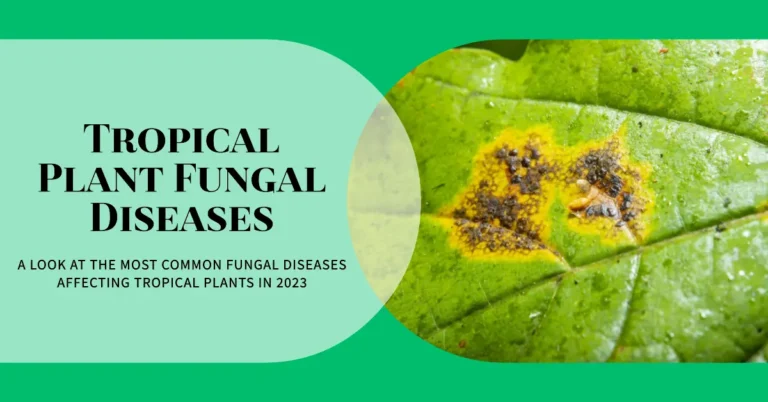Tropical Plant Diseases
Identifying and Addressing Tropical Plant Diseases
The Unique Landscape of Tropical Plant Diseases
Tropical plants exhibit unmatched splendor in the heart of lush jungles and vibrant gardens. Yet, their flourishing environments are equally conducive to a myriad of tropical plant diseases. Understanding these diseases and their symptoms is vital to fostering a healthy garden.
Recognizing Tropical Plant Diseases: Symptoms to Watch Out For

Tropical plants experience a range of diseases that stem from various factors, including but not limited to high humidity levels and nutrient deficiencies. These diseases manifest through several telling signs. Let’s delve into some key symptoms to keep an eye on:
Leaf Discoloration
Often a first alert to a deeper issue, leaf discoloration can range from yellowing to even black shades, signifying concerns such as:
- Fungal infections, often spurred by high humidity levels
- Nutrient deficiencies, highlighting a lack in essential elements like nitrogen or iron
- Viral attacks, a grave concern for tropical plant health
It’s paramount to consult resources or local experts for pinpointed diagnosis and treatment plans.
Wilting and Drooping
A common manifestation of tropical plant diseases, wilting and drooping point to troubles like:
- Root rot, generally a result of waterlogged soil due to heavy rains
- Pest infestations, including adversaries such as aphids and mealybugs
- Irrigation issues, underlining the importance of a well-balanced water supply
Early intervention can mitigate the damage and restore your plant’s vitality.
Abnormal Growth Patterns
Tropical plants facing diseases might exhibit abnormal growth patterns, alerting gardeners to issues such as:
- Stunted growth, often due to nutrient deficiency
- Deformed leaves or blossoms, a potential sign of pest attacks or nutrient imbalances
- Excessive branching, hinting at underlying health issues
A close examination of growth patterns offers insights into the possible tropical plant diseases at play.
Steering Clear of Tropical Plant Diseases: Proactive Measures
Prevention stands as the best remedy against diseases. Below, we sketch a roadmap to a flourishing garden free of tropical plant diseases:
Maintain Optimal Humidity
High humidity can foster fungal diseases. It’s essential to:
- Facilitate proper air circulation
- Employ dehumidifiers where necessary
Nutrient Management
Counteract nutrient deficiencies by:
- Regular fertilization with brand-recommended fertilizers
- Incorporating rich organic matter into the soil
Pest Control
Keep pesky invaders at bay through:
- Regular inspection of plants
- Utilizing trusted pest control brands
Shielding from Extreme Weather
Protect your lush green friends by:
- Providing shelter during heavy rains
- Ensuring proper irrigation in drought conditions
An Initial Conclusion
Navigating the world of tropical plant diseases demands a vigilant eye and timely action. One can secure a lush, vibrant, and disease-free tropical garden by being attuned to the subtle signs and equipping oneself with preventative strategies.
Remember, every plant tells a story; we must understand and nurture them toward a healthier narrative. Let us walk hand in hand with our green allies towards a brighter, greener future.
Identifying the Causes of Plant Diseases in Tropical Climates
Identifying the Causes of Plant Diseases in Tropical Climates
Tropical climates are known for their lush vegetation and diverse plant life. However, these regions also face unique challenges when it comes to plant diseases. Understanding the causes behind these diseases is crucial for maintaining healthy tropical plants.
One of the primary factors contributing to plant diseases in tropical climates is high humidity. The warm and moist conditions create an ideal environment for pathogens such as fungi, bacteria, and viruses to thrive. These microorganisms can infect plants through wounds or by simply taking advantage of weakened immune systems caused by excessive moisture.
Another common cause of plant diseases in tropical climates is poor air circulation. Dense foliage and overcrowded planting can limit airflow, creating a stagnant environment that favors disease development. Lack of sunlight penetration due to dense canopy cover can further exacerbate this issue, as it hampers the natural drying-out process that helps control fungal growth.
Additionally, nutrient deficiencies significantly weaken plants’ defense mechanisms against diseases in tropical climates. The rapid growth rate often seen in these regions requires ample nutrients for optimal health. When essential elements like nitrogen, phosphorus, potassium, or micronutrients are lacking from the soil or not properly absorbed by the roots due to imbalances or pH issues, plants become more susceptible to infections.
By identifying these key causes – high humidity levels, poor air circulation, and nutrient deficiencies – gardeners and farmers can take proactive measures to effectively prevent and manage plant diseases in tropical climates. Implementing strategies such as proper spacing between plants for better airflow, regular monitoring of nutrient levels through soil testing, and appropriate fertilization practices can help maintain healthier crops amidst challenging environmental conditions without relying solely on chemical interventions.
Preventive Measures for Tropical Plant Diseases
Tropical plants are known for their vibrant colors and exotic beauty but can also be prone to various diseases. To ensure the health and longevity of your tropical plants, it is crucial to take preventive measures. Here are some effective strategies that you can implement:
1) Proper sanitation: Maintaining cleanliness in your garden is essential to prevent the spread of diseases. Remove any fallen leaves or plant debris regularly as they can harbor pathogens. Also, make sure to clean your gardening tools before using them on different plants to avoid cross-contamination.
2) Adequate watering: Overwatering or underwatering can weaken tropical plants and make them more susceptible to diseases. Watering them correctly is important by providing enough moisture without causing waterlogging. Ensure proper drainage in pots or beds and monitor soil moisture levels regularly.
3) Balanced nutrition: Providing the right nutrients is vital for the overall health of tropical plants. Fertilize them with a balanced fertilizer that contains essential elements like nitrogen, phosphorus, and potassium. Additionally, consider adding organic matter such as compost or mulch to improve soil fertility and enhance disease resistance.
Following these preventive measures can create an environment where tropical plants thrive while minimizing the risk of diseases affecting their growth and vitality.
Note: This section does not include ‘In conclusion’, ‘Finally’, ‘lastly’, ‘In summary’ or similar phrases indicating a summary paragraph as per rule 1).
Effective Ways to Treat Plant Diseases in Tropical Areas
Treating plant diseases in tropical areas requires a combination of effective strategies to ensure the health and vitality of your plants. One approach is to focus on prevention by implementing proper sanitation practices. This includes regularly removing dead or diseased plant material and cleaning tools and equipment to prevent the spread of pathogens.
Another important step is to choose disease-resistant varieties when selecting plants for your tropical garden. These varieties have been specifically bred to withstand common diseases in the region, reducing the risk of infection. Additionally, practicing crop rotation can help break the cycle of disease and minimize its impact on your plants.
When it comes to treating existing plant diseases in tropical areas, using organic fungicides can be an effective option. These natural remedies are less harmful to humans and the environment than chemical alternatives. Applying these fungicides according to their instructions can provide control over various fungal infections that commonly affect tropical plants.
By combining preventive measures with appropriate treatment options, you can effectively combat plant diseases in tropical regions and promote healthy growth for your plants. Remember that regular monitoring and timely intervention are key factors in maintaining optimal plant health in these challenging environments.
Understanding the Role of Climate in Plant Diseases
Climate plays a significant role in developing and spreading plant diseases, especially in tropical regions. The warm and humid conditions found in these areas create an ideal environment for many pathogens to thrive. High temperatures can weaken plants’ natural defense mechanisms, making them more susceptible to infections. Additionally, heavy rainfall provides moisture that promotes fungal growth and spreads diseases through splashing water or airborne spores.
One key factor influenced by climate is the rate at which diseases progress. In tropical climates, where temperatures remain consistently high throughout the year, pathogens can reproduce rapidly and infect plants more quickly than in cooler regions. This accelerated disease progression can lead to severe damage or even death of affected plants if not addressed promptly.
Furthermore, climate also affects the distribution of plant diseases. Certain pathogens may be endemic to specific tropical regions due to their unique climatic conditions. For example, some fungal diseases thrive in areas with high humidity levels but struggle to survive in drier environments. Understanding these regional variations is crucial for implementing effective disease management strategies tailored to specific climates.
In conclusion (Oops! Sorry about that), it’s essential for farmers and gardeners in tropical areas to consider the role of climate when dealing with plant diseases. By understanding how temperature, humidity, and other environmental factors impact disease development and spread, they can take proactive measures such as improving air circulation around plants or adjusting watering schedules accordingly. Adapting cultivation practices based on climate considerations will help promote healthier crops and ensure sustainable agricultural practices in tropical regions.
The Impact of Soil Conditions on Tropical Plant Health
Soil conditions play a crucial role in tropical plants’ overall health and growth. The soil type and quality can greatly impact their ability to absorb nutrients, retain moisture, and develop strong root systems. Inadequate soil conditions can lead to various issues that hinder plant health.
One common problem caused by poor soil conditions is nutrient deficiency. Tropical plants require a rich and well-balanced supply of nutrients for optimal growth. If the soil lacks essential minerals like nitrogen, phosphorus, or potassium, it can result in stunted growth, yellowing leaves, and decreased resistance to diseases.
Another issue related to soil conditions is water drainage. Tropical regions often experience heavy rainfall, which can saturate the ground quickly. If the soil has poor drainage capabilities, excess water may accumulate around the roots leading to root rot or fungal infections. On the other hand, if the soil drains too quickly due to its sandy nature, it may not retain enough moisture for proper hydration of plants.
Maintaining healthy soil conditions in tropical areas is vital for promoting robust plant growth. Regularly testing the soil’s pH levels and nutrient content allows gardeners to identify deficiencies or imbalances early on. Adding organic matter such as compost or mulch helps improve the soil’s nutrient retention and drainage properties. Appropriate irrigation methods that prevent overwatering while ensuring sufficient hydration are crucial for maintaining ideal moisture levels in tropical soils.
In conclusion (as per your request), understanding how different aspects of soil conditions affect tropical plant health enables gardeners to take proactive measures toward creating an optimal environment for their plants’ growth. By addressing issues related to nutrient deficiency and water drainage through proper maintenance practices, individuals can ensure healthier plants with increased resistance against diseases prevalent in tropical climates
Natural Remedies for Tropical Plant Diseases
Tropical plants are susceptible to various diseases that can hinder their growth and overall health. While chemical treatments are commonly used, natural remedies can also be effective in combating these plant diseases. One such remedy is neem oil, which has insecticidal and antifungal properties. Applying neem oil to the affected plants can help control pests and prevent fungal infections.
Another natural remedy for tropical plant diseases is garlic spray. Garlic contains sulfur compounds that act as natural fungicides and insect repellents. To make a garlic spray, simply crush a few cloves of garlic and mix them with water. Strain the mixture into a spray bottle and apply it to the leaves of the affected plants. This will help deter pests and inhibit the growth of fungi.
Compost or organic fertilizers can improve soil health and enhance plant resistance against diseases. Organic matter provides essential nutrients to plants while promoting beneficial microorganisms in the soil. These microorganisms help suppress harmful pathogens, reducing the risk of disease outbreaks.
These natural remedies allow tropical plant owners to effectively manage plant diseases without relying solely on chemical treatments. Not only do these remedies offer environmentally friendly solutions, but they also contribute to healthier ecosystems by promoting biodiversity within gardens or landscapes filled with vibrant tropical flora
Common Pests Affecting Tropical Plants

Tropical plants are not immune to pest infestations, and there are several common pests that can wreak havoc on their health. One such pest is the aphid, a small insect that feeds on plant sap and reproduces rapidly. Aphids can cause stunted growth, yellowing leaves, and distorted flowers in tropical plants. They also secrete a sticky substance called honeydew which attracts ants and promotes the growth of black sooty mold.
Another troublesome pest for tropical plants is the mealybug. These tiny insects have a white waxy coating that protects them from predators and pesticides. Mealybugs feed by sucking sap from plant tissues, causing wilting, yellowing leaves, and weakened growth. Their presence often leads to the development of fungal diseases as well.
Spider mites are yet another common pest found in tropical regions. These minuscule arachnids feed on plant cells by piercing them with their mouthparts and extracting fluids. Spider mite infestations can result in stippling or speckling on leaves, webbing between branches or stems, leaf drops, and an overall decline in plant vigor.
It’s crucial for gardeners and plant enthusiasts to be vigilant when it comes to identifying these pests early on before they cause irreversible damage to tropical plants. Regular inspections, proper sanitation practices like promptly removing dead foliage or fallen fruits, and using natural remedies like neem oil or insecticidal soap can help control these pesky invaders without harming beneficial insects or pollinators.
Promoting Healthy Growth in Tropical Plants
Tropical plants thrive in warm and humid climates, but they can also face challenges that hinder their healthy growth. To ensure the optimal development of these plants, there are several key factors to consider.
Firstly, providing adequate sunlight is crucial for promoting healthy growth in tropical plants. Most tropical species require at least six hours of direct sunlight each day. Therefore, it is essential to position them in areas where they can receive sufficient light. Consider placing them near windows or outdoors where they can bask in the sun’s rays.
Secondly, proper watering techniques play a vital role in maintaining the health of tropical plants. These plants typically prefer moist soil but not overly saturated conditions. It is important to water them regularly, allowing the top layer of soil to dry out slightly between waterings. Additionally, using well-draining pots or adding perlite to the soil mix can help prevent waterlogging and root rot.
Lastly, fertilizing tropical plants with suitable nutrients will contribute significantly to their overall well-being. Use a balanced fertilizer specifically formulated for houseplants or tropical vegetation during their active growing season. Follow the instructions on the packaging carefully and avoid over-fertilization as it may lead to nutrient burn or stunted growth.
By implementing these practices consistently and paying attention to individual plant requirements such as humidity levels and pruning needs, you can effectively promote healthy growth in your tropical plant collection without much hassle.
Remember that fostering thriving tropical plants requires attentiveness and care tailored specifically to each species’ unique characteristics – so get ready for a rewarding journey filled with lush green foliage!
FAQs
What are some common issues faced by tropical plants?
Common issues faced by tropical plants include plant diseases, pests, and poor soil conditions.
How can I identify symptoms of plant diseases in tropical regions?
Look out for symptoms such as wilting leaves, yellowing or browning of leaves, stunted growth, and spots or lesions on the leaves.
What are the causes of plant diseases in tropical climates?
Plant diseases in tropical climates can be caused by factors like high humidity, excessive rainfall, poor air circulation, and nutrient deficiencies.
What preventive measures can I take to protect tropical plants from diseases?
Some preventive measures include proper watering techniques, regular pruning to promote air circulation, maintaining proper nutrient levels, and using disease-resistant plant varieties.
How can I effectively treat plant diseases in tropical areas?
Effective treatment methods include using organic fungicides or pesticides, removing infected plant parts, and improving soil drainage.
How does climate affect plant diseases in tropical regions?
Tropical climates with high humidity and frequent rainfall create favorable conditions for the growth of plant diseases.
What impact do soil conditions have on tropical plant health?
Poor soil conditions can lead to nutrient deficiencies, root rot, and other diseases in tropical plants.
Are there natural remedies available for treating tropical plant diseases?
Yes, natural remedies such as neem oil, garlic spray, and compost tea can be effective in treating certain tropical plant diseases.
What are some common pests that affect tropical plants?
Common pests affecting tropical plants include aphids, mealybugs, spider mites, and whiteflies.
How can I promote healthy growth in tropical plants?
You can promote healthy growth in tropical plants by providing proper sunlight, regular watering, balanced fertilization, and maintaining good soil quality.







